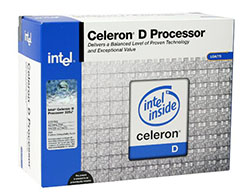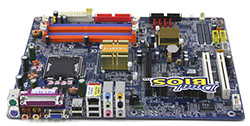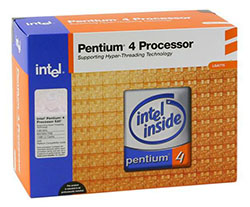Buyer's Guide - Entry Level to Mid-Range, March 2005
by Jarred Walton on March 15, 2005 1:30 PM EST- Posted in
- Guides
CPU and Motherboard: Intel
Unlike the AMD picture, where we have some real changes from our last Budget Guide, the Intel budget offerings are pretty much the same as last time. Considering the increased performance, lower power/heat requirements, and potential for 64-bit support that AMD offers, Intel doesn't really look that good. EM64T is only available starting at the $200+ processors, although we should start seeing some new Celeron D parts in Q2 that include EM64T. However, since we've switched from socket A in AMD-land, we'll ditch socket 478 in Intel-land as well. They're both being phased out rapidly these days, so we can't see advocating a purchase of a new system using a dying platform anymore.For a budget system, we're still looking primarily at Celeron D processors, as even the cheapest Pentium 4 chips will cost $150. (Certain socket 478 Pentium 4 chips are slightly cheaper, but again, we can't see recommending the 478 platform.) The motherboard chipset is a little harder to decide on, as you have 865 and 915 offerings to sort through. 865G/PE will cost less typically and allow you to use an AGP card, while 915G/P support PCI Express graphics cards. If you want integrated graphics, we'd go with an 865G motherboard, as the 915G boards are all rather expensive for a budget system. 865PE with a cheap AGP card would cost as much as most 915G boards (and generally perform better as well)! We're going to avoid the IGP options on socket 775 for this reason and go with 915P.
 |
 |
| Click images to enlarge. | |
Socket 775/T Motherboard: EPoX EP-5EPAJ 915P
Price: $82 shipped
Socket 775/T CPU: Intel Celeron D 325J 2.53 GHz 256K L2 Cache
Price: $84 shipped (Retail)
Total: $166
The best that we could come up with for a reasonable 775 system again uses an EPoX motherboard. Features are similar to the 8KDA3J that we used for our AMD system, only with an Intel chipset instead of an NVIDIA chipset. The hardware firewall is no longer present, of course, but gigabit Ethernet remains. Firewire support and HD audio are also missing. Remember that the 915 chipset is a PCI Express solution, so you will need a newer graphics card in order to use this motherboard. 915G motherboards will remove this requirement, but we suggest that you stick with the more expensive 915G as opposed to the 915GV/GL chipsets. See our alternative choice below.
Our processor of choice happens to be the cheapest (and slowest) option available for socket 775. It's not necessarily bad, of course, and for most tasks, it will perform well enough. Gaming is not one of those tasks, however, so if that's what you're after, go back to the AMD recommendations, please.
 |
 |
| Click images to enlarge. | |
Socket 775/T Motherboard Alternative: Gigabyte GA-8I915G Pro i915G
Price: $99 shipped
Socket 775/T CPU Alternative: Intel Pentium 4 520 2.8 GHz 1024K L2 Cache
Price: $152 shipped (Retail)
Total: $251
Our alternative upgrades to the base socket 775 recommendation uses a Gigabyte motherboard for its improved features. Among the additions are Azalia HD audio support and firewire ports, and we even get the integrated GMA-900 graphics as a bonus. Truth be told, you could use this motherboard as the "budget" option and skip the requirement for an add-in graphics card. The 915G and 915P chipsets are otherwise identical, so having the VGA port doesn't hurt, even if you never use it. The one area where the Gigabyte board may fall a little short is in overclocking support. If that's a real concern, the Abit AG8 is probably the next step up, but prices increase rapidly.
Our upgraded processor choice for Intel is once again their cheapest offering for socket 775; only this time, we've eliminated the Celeron from contention. That leaves us with the Pentium 4 520J, and the price is unchanged from our last budget Guide. At 2.8 GHz, the Pentium 4 is typically slower than any of the Athlon 64 processors. Of course, Intel still does a little better in a few applications like video encoding, provided that they have proper optimizations for the architecture. This is the bare minimum Intel P4 system with PCI Express support, though, and most people will be satisfied with the performance.










59 Comments
View All Comments
LoneWolf15 - Wednesday, March 16, 2005 - link
Note on the Hitachi hard disk drives:Hitachi is the ONLY major company that does not allow advance-exchange RMA of their hard disks. To me, this is huge when looking at a hard disk. Western Digital, Seagate, and Maxtor all have advanced exchange. After the nightmares I have had with IBM and Hitachi technical support, I could not in all honesty recommend them in a system. Personally, I can't afford that kind of downtime, having an advance replacement makes it easier to try and recover data from a crashed drive if necessary, and you aren't waiting in limbo while someone receives your defective drive, checks it in, diagnoses it bad, then sends you out a replacement, also placing you at the mercy of their stock-on-hand or whomever they choose to ship to you the replacement drive.
neologan - Wednesday, March 16, 2005 - link
There's another buyers guide at http://www.pureoverclock.com/review.php?id=9 but it doesn't choose its recommedations due to a really strict budget. Worth a read though i guess.JarredWalton - Wednesday, March 16, 2005 - link
26 - Thanks. Identity crisis indeed! I was originally looking at upgraded S754 instead of S939, but decided against it. :)As a side note, RAM prices have suddenly taken a massive cut. The PDP 2-3-2-5 is now $20 less than last week, and it's about $50 less than a couple months ago. Heck, you can even get 1GB (2x512) of Corsair CL2.5 for under $100 now - again, $50 less than last Guide!
chrisd154 - Wednesday, March 16, 2005 - link
"Socket 754 Alternative Motherboard: Chaintech VNF4 Socket 939""Socket 754 CPU: AMD Athlon 64 1.8 GHz 512KB L2 90nm socket 939"
Your socket 754 motherboard and cpu are having a bit of an identity crisis (i.e theyre 939). You might want to correct that mate.
JarredWalton - Wednesday, March 16, 2005 - link
24 - you want benchmarks of the speakers? Sorry, that's *way* beyond the scope of this Guide. Speakers costing $60 or less aren't being purchased primarily for their quality; they're being selected for price.If you mean benchmarks in general, that's something that would be great to have but not practical to do. Our various hardware reviews are meant to address the theory of what makes a good component/computer. For many of the parts in a budget system, price is a bigger factor than the final performance or quality. Sure, we'd like to have both, but the truth is you're not going to get SLI in a budget system. We do not have all of the parts available in one location for testing, and some of the parts may not even be in AnandTech's possession [anymore]. This is especially true of entry-level Guides, as many of the parts were new a year or more in the past
If you'd like specific information or you have a specific question, feel free to email me.
crimson117 - Wednesday, March 16, 2005 - link
I'd appreciate if you could add some benchmarks to compare "beeps and boops" quality. This guide is pretty much worthless without them.JarredWalton - Wednesday, March 16, 2005 - link
The MSI uATX is the only ATI Xpress 200 board currently available, and it's basically the same price as the Chaintech. Given that it's still pretty new, I'm a little hesitant to go with that over the "proven" nF4. Oh, and there are *no* overclocking options on the MSI board right now. Is that a BIOS problem or a chipset problem? I don't know. If you really like ATI or if you want a uATX form factor, it's definitely an option.kmmatney - Tuesday, March 15, 2005 - link
I'd consider the MSI ATI Radeon XPRESS 200 motherboard board for a budget system as well. From reviews I've read, using the on-board video doesn't seem to degrade overall 2D performance.Pair it with an Athlon 64 3000+ winchester for $235. A decent system for the non or light gamer, and you have the option of upgrading the video later. Too bad there aren't any budget 939 cpus.
JarredWalton - Tuesday, March 15, 2005 - link
I haven't had issues with the Chaintech, but that's only one person's experience with a specific RAM/GPU setup. The documentation is pretty lacking, but other than that it works well. Are you speaking from personal experience, and if so, what was the exact configuration (RAM, CPU, PSU, etc.)? It works well in the following configuration, although I had to manually set the RAM timings:Athlon64 3500+
Chaintech nForce4 VNF4
ATI X800 XL 256MB PCIe
1GB (2x512) Corsair DDR400 CAS2.5
Antec True430 PSU
NEC ND-3520A DVD±RW
WD 200GB SATA
SB Audigy 2 ZS
As for the DVD+RW, why save $20 when there won't be anything faster than a 16X burner, and the ability to backup 4.5GB of data rather than 700MB can come in handy? (And if that sounds like too much data, consider that a lot of people take digital pictures these days. A few hundred high quality images will fill a CD.) I mentioned the possibility to downgrade the optical drive, but I'm not going to recommend it.
mostlyprudent - Tuesday, March 15, 2005 - link
Are you serious ... recommending a motherboard with compatability and stability problems just to save $10? And why put a DVD-RW drive in a budget system? Optical drives are quite simple to upgrade down the road. You would have to be crazy to skimp on the quality of the motherboard to fit in an upgraded optical drive. You can get a DVD-ROM/CD-RW combo drive for about $20 less than the NEC drive you suggest. I would take that $20 dollars and invest it in a stable/reliable motherboard -- there is nothing worse than a finiky mobo as far as I'm concerned.